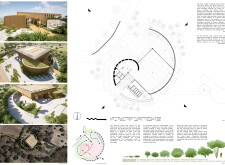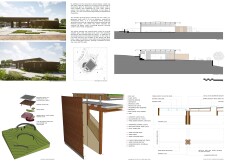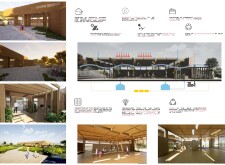5 key facts about this project
This architectural design represents a commitment to sustainability and community interaction. The spiral layout encourages movement through various interconnected spaces, facilitating an organic flow from one area to another. The building includes multipurpose rooms, communal kitchens, and outdoor patios that are intended to foster social interaction among community members. Each space has been meticulously planned to serve a specific function while remaining flexible enough to adapt to the diverse needs of those who utilize the center.
A key feature of the Spirala Community Center is its thoughtful material selection, which emphasizes sustainability and aesthetic appeal. Laminated certified wood serves as the primary structural material, offering both strength and warmth. Natural stone has been integrated into the design, grounding the building within its environment while contributing to its durability. The use of translucent tiles ensures ample natural light floods the interiors, creating a welcoming atmosphere. Additionally, the metal roofing provides structural integrity and longevity to the building.
The integration of natural elements is a fundamental aspect of this project. The surrounding landscape has been carefully considered, with native plants included in the design to promote local biodiversity. A stone wall serves as a transition between indoor and outdoor spaces, highlighting the relationship between the building and its site. Large openings along the building's facades facilitate cross-ventilation, ensuring that fresh air flows throughout the interior spaces. Skylights complement this approach by enhancing daylighting, contributing to the energy efficiency of the center.
A unique approach to design is evident in the multifunctionality of the spaces within the community center. The central multipurpose room can accommodate a variety of uses, from educational classes to social gatherings. This flexibility is complemented by strategically placed storage spaces and kitchen facilities that cater to the community’s diverse activities. The design not only addresses practical needs but also encourages interaction, reinforcing the notion of a vibrant community hub.
Moreover, the project emphasizes energy sustainability. The incorporation of photovoltaic panels reduces the building's reliance on external energy sources, while rainwater collection systems are designed for irrigation, showcasing a commitment to environmental stewardship and responsible community practices. This focus on eco-friendly solutions aligns with contemporary architectural ideas that prioritize sustainability and resilience.
The Spirala Community Center is a prime example of how architecture can create spaces that enhance community living while respecting the surrounding environment. Its spiral design not only serves a practical purpose but also adds a unique aesthetic to the structure, reflecting the values of connection and community at its core. This project stands as a testament to the potential of thoughtful architectural design to promote social engagement and sustainability.
For those interested in exploring architectural plans, architectural sections, and detailed architectural designs of the Spirala Community Center, it is encouraged to delve further into the project presentation. Such an examination offers a deeper insight into the innovative architectural ideas that underpin this community-focused project.


























